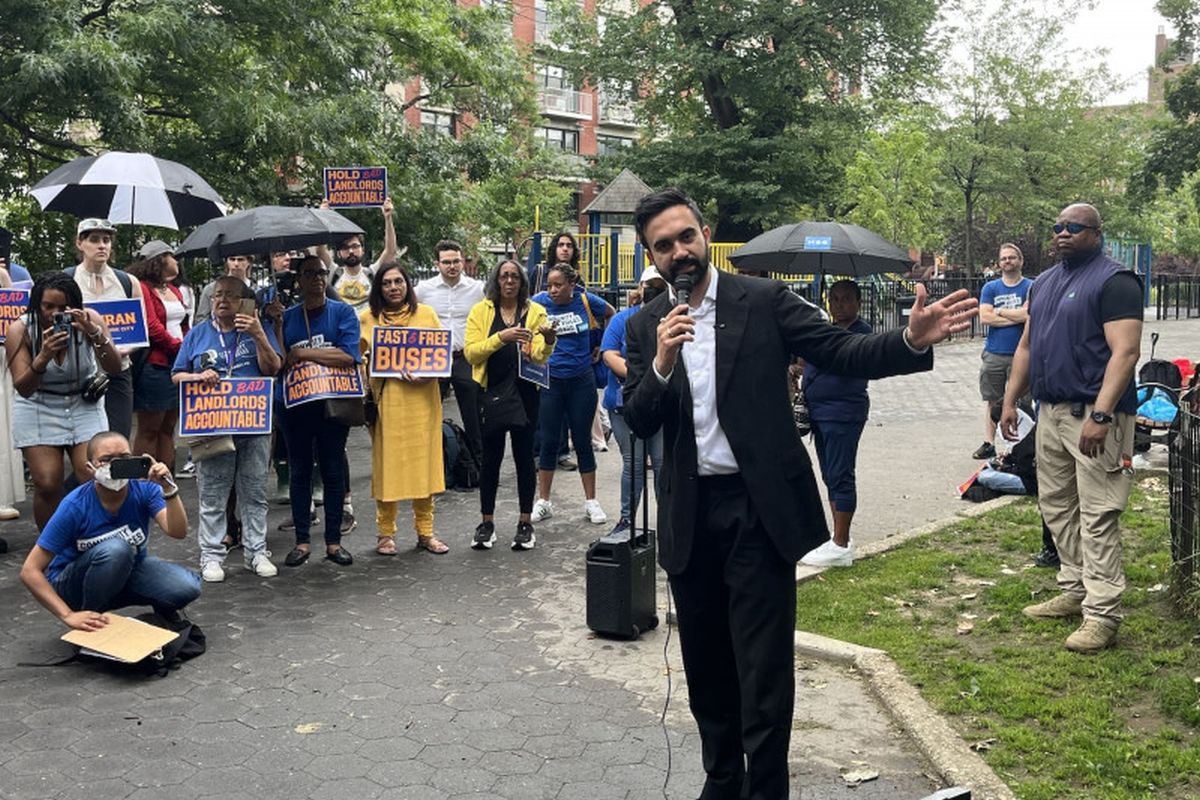
More than anything, November 4 — the first national election since Trump’s return to the presidency — represented a profound rejection of the far-right administration. After just one year in office, Trump trampled fundamental democratic rights, promoted alarming authoritarian maneuvers, and terrorized America’s most oppressed communities. Furthermore, he scrapped any promises to improve the economic interests of the working-class voters who gave him their votes after Biden failed to deliver stability during his four years in office, instead leaving workers at the mercy of the worst consequences of economic insecurity.
Democratic candidates won gubernatorial elections by wide margins in Virginia and New Jersey. In the latter state, the Democratic wave extended to the Legislative Assembly elections, where they obtained the largest majority in 52 years. However, the most important contest of the night was Zohran Mamdani’s victory. In the financial heart of the city, the self-proclaimed “democratic socialist” won the votes of more than a million New Yorkers with a program that promised to combat the far right, oppose the Israeli genocide in Gaza, and implement progressive policies to make the city affordable for the multiracial working class. Mamdani’s victory was so overwhelming that it was announced just 30 minutes after the vote counting began.
Anti-Trump sentiment even manifested itself in a ballot initiative in California. The Proposition 50 is a proposal that redraws electoral districts to favor Democratic voters. Of all the election results on Tuesday, Trump was the angriest—and most vocal—about this move. That’s because it represented a clear rejection, in a traditionally Democratic state, of Republican attempts to gerrymander electoral districts across the country. The measure was approved by an overwhelming majority and NPR (National Public Radio, the public broadcasting network of the United States) considers it the largest victory for Democrats, to date, in the national battle over redistricting ahead of the 2026 midterm elections.
Manu Raju, CNN anchor and chief Congress correspondent, wrote that “the main conclusion of the Democrats is that this is an anti-Trump electorate”. He also pointed out that “Democrats have used the anti-Trump message in every election cycle since 2016, with mixed results”. CNBC reported that in Virginia, 10% of voters surveyed expressed an unfavorable opinion of both parties. Of this group, 72% supported Democratic Governor-elect Abigail Spangberger.
From New York and New Jersey to Virginia and California, voters expressed what was already evident from Trump’s steadily plummeting approval ratings, street clashes defending immigrants from Los Angeles to Chicago, and stories of woe from workers suffering from Trump’s cuts to programs like SNAP and Medicare and the mass dismantling of public sector jobs: Workers are seeing that Trump’s reactionary program is not a program for the country’s multiracial working class.
What path should Democrats follow?
The election results in Virginia, New Jersey and New York have given new impetus to the Democratic Party, which has been on the defensive since Trump’s re-election. For the most moderate analysts and politicians of the Democratic Party, these victories confirm their conviction that a populist platform contrary to the woke ideology is the way forward.
Spanberger began his victory speech by stating that his campaign “sent a message to our neighbors, to the entire country and to the entire world: that in 2025 Virginia chose pragmatism over partisanship”. Rebecca Michelle “Mikie” Sherrill -New Jersey-, for her part, focused her acceptance speech on the “prosperity”linking appeals to the American democratic tradition with the people’s need for economic security. He added that the election shows that “We are not going to give in to our darkest impulses.”not to mention the transphobic, racist, and anti-immigrant hate that characterized much of his Republican opponent’s campaign and Trump’s politics.
Democrat House Speaker Hakeem Jeffries, who two days ago told CNN host Jake Tapper that the future of the Democratic Party lay not with Zohran Mamdani, but with the House Democratic caucus, said Tuesday night that Democrats “they won across the country talking about the affordable housing crisis”. An ABC News article confirms that the elections in Virginia and New Jersey focused on the issue of affordable housing, but the debate over how to resolve it differs considerably in these states compared to New York.
While Mamdani based his campaign on high-profile proposals like free buses, rent freezes in rent-controlled housing, and municipal supermarkets to improve affordability, Sherrill and Spanberger focused their campaign primarily on differentiating themselves from Trump. It is true that Trump’s irresponsible tariffs, his benefits to important sectors of capital such as Big Tech, and the dismantling of essential programs for workers have affected the livelihoods of people from Virginia to New Jersey. This made it easier for Sherrill and Spanberger to present themselves as alternatives without having to say much beyond: Trump is hurting them; we listen to them; We will not be like him. While this may have brought them big victories in these elections, none of them can claim to have what Mamdani’s campaign does: a vibrant movement of over a hundred thousand volunteers driven by a vision for the future.
One of the main reasons Democrats lack a strategy to confront Trump is due to the ideological divide between the party’s internal factions. As Madeleine Freeman, editor of Left Voice, points out, the Democratic Party is facing an existential crisis linked to the general crisis of neoliberalism. Key figures in the Democratic Party, such as Gavin Newsom and Hakeem Jeffries, avoided mentioning Mamdani’s resounding victory. One conclusion that emerges from Democratic analysts is that they can win by adopting an inclusive party vision, thus accepting the deep internal divisions between an insurgent populist wing and a centrist wing that seeks to limit concessions to the working class in order to do whatever is necessary to further US imperialist interests. This is an attempt to downplay the successes of progressives like Mamdani, whose policy proposals have captivated people across the country in need of relief after years of growing economic hardship.
But these competing visions within the Democratic Party cannot coexist for long, something has to give when millions of people expect the Mamdani administration to create change for working people and serve as a model for similar programs across the country.
This demonstrates the limitations of Jacobin and the DSA’s argument about the left’s ability to reorient the Democratic Party and convince it to realign with its traditional base in the working class and the oppressed. As Freeman points out, “The crisis of the Democrats and the threat to their ability to govern was never simply the result of a series of political decisions over the last two decades”but rather “an expression of a crumbling political order that has not yet been reconfigured”.
Because Democrats—even their most progressive sector—refuse to make a deep break with capitalism and instead seek to “reform” it, they are unable to offer anything other than a return to the status quo of capitalist domination and rule over the working class and the oppressed.
Class independence is key
This makes the Democratic Party a dead end for the working class and the oppressed, who will always have to pay for the crises that capitalism creates. If the working class wants results different from those we have obtained in recent years, we must mobilize in a collective fight against the rich, in the streets and in our workplaces. This is especially true now that Trump is waging an offensive to reform the political regime.
Mamdani’s base could be the seed of this united front needed to confront the right and forge the possibility of a national organization independent of the Democrats. Mamdani himself is a Democrat and now, as an executive in a city ruled by capitalists, he will play the role of mediator between tenants and landlords, businessmen and workers, police and protesters. However, its base is made up of nurses, teachers, babysitters, bus drivers, students, immigrants, Palestinians, anti-Zionist Jews, and all the New Yorkers who make New York City an expression of broader dynamics across the United States.
These sectors, which have been fighting for months for a city that belongs to them, can and must continue to organize in the face of the attacks from Trump and the Democratic Party. This means not expecting Zohran to deliver on his most left-wing campaign promises. It doesn’t even mean pressuring him to comply. It means organizing at the grassroots level, knowing that it is the working class that makes everything run, from New York to New Jersey to Virginia to California and the rest of the country. The debate about socialism and the fight against the extreme right has begun. Now is the time to bring that passion to our workplaces, our schools, our streets and our unions, using these spaces to imagine, on our own terms, the way out of the misery that the bipartisan regime continues to impose.
*Article originally published in Left Voice, member of the International Network La Izquierda Diario
Source: www.laizquierdadiario.com

